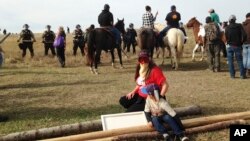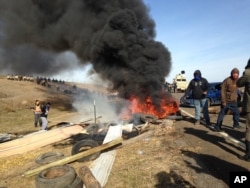Protesters clashed with police Thursday in the state of North Dakota at a site where activists have been trying for months to block construction of an oil pipeline that they say encroaches on territory occupied by American Indians.
The local sheriff, Kyle Kirchmeier, told reporters that the land was cleared of protesters, although some news reports said not everyone had left the area. Some protesters were arrested, although no details were immediately available.
Unlawful behavior
Demonstrators near the Dakota Access Pipeline work site “escalated unlawful behavior” in recent days, the sheriff said, by setting up illegal roadblocks and trespassing on private property with an encampment of teepees, tents and other structures.
Kirchmeier said he gave protesters a final warning Wednesday to leave or be forced out, because the roadblocks and the trespassing were a threat to public safety. Clashes began when law-enforcement officers started to remove the protesters’ roadblocks Thursday.
Local police arrived in riot gear, along with reinforcements from seven other states, and began removing the roadblocks and dispersing the protesters. Authorities used a sound cannon to scatter the activists, who set fire to some of their barricades built of car tires and wood.
Construction of the Dakota Access Pipeline is nearly complete. The project traces a 1,700-kilometer path across the north-central United States and is intended to transport at least 400,000 barrels of crude oil a day from two North Dakota oil fields to a pipeline hub in the state of Illinois. The fuel’s ultimate destination would be ports and refineries in various parts of the country.
Tribe says water threatened
American Indians and their supporters, who include Green Party presidential candidate Jill Stein and veteran civil-rights activist Jesse Jackson, say the pipeline will put their water supply at risk and damage areas sacred to the local Standing Rock Sioux tribe.
Protests have been building in intensity since July, when the builders obtained a permit to route the pipeline beneath the Missouri River at a place called Lake Oahe, less than 1 kilometer from the Standing Rock Sioux reservation.
Hundreds of supporters came to Lake Oahe to support the local Sioux protesters. More than half of all Native American tribes in the U.S. have aligned themselves with the Standing Rock Sioux, and a number of members of Congress have written letters urging the Obama administration to stop the pipeline.
The federal government did ask the pipeline crews to stop construction work voluntarily near the Sioux reservation, while authorities reconsider the plans, but courts have refused to enforce the stop-work order.











